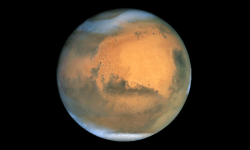
An underground ocean would be responsible for the large fractures visible on Charon
– News of February 19, 2019 –
Charon, Pluto’s moon, was photographed by the spacecraft New Horizons. Charon has a diameter of 1200 km, which makes it a huge moon compared to its planet. Its icy surface is lacerated with faults, mountains and impact craters. North of Charon, a dark region is visible. It was named Mordor. On one of its faces, Charon seems divided by a series of long scars along its equator, with a southern hemisphere appearing smoother than the northern hemisphere.
A team of researchers now thinks they can explain this difference between the north and south of the Pluto‘s moon. After its creation, Charon were warm enough to keep a liquid ocean under his ice crust. This ocean has submerged part of the southern hemisphere. The remodeling of this region could been explained by several causes : slowly and gradually thanks to cryovolcans gradually pouring water ice and ammonia. They would eventually cover the whole area, giving it its smooth appearance. We can also think that the crust of this part of Charon would have fragmented before sinking in the ocean below. This hypothesis is consistent with some of the morphological aspects spotted on the surface of the Pluto’s moon.
Other frozen bodies in the solar system also have a fairly young surface that seems to have been disrupted in the recent past, Europe and Enceladus for example. Europe has a very smooth surface, almost without impact crater. Each time, the hypothesis of an underground ocean is privileged to explain the observed geological activity. We can easily imagine that it was the same for Charon. The ocean beneath the surface of Charon would have frozen for a long time by passing from the liquid state to the solid state, this ocean would have inflated, which would have made larger the Pluto’s moon. This swelling is the cause of large fractures visible near the equator of Charon.
Picture by NASA / Johns Hopkins Applied Physics Laboratory / Southwest Research Institute / Alex Parker









